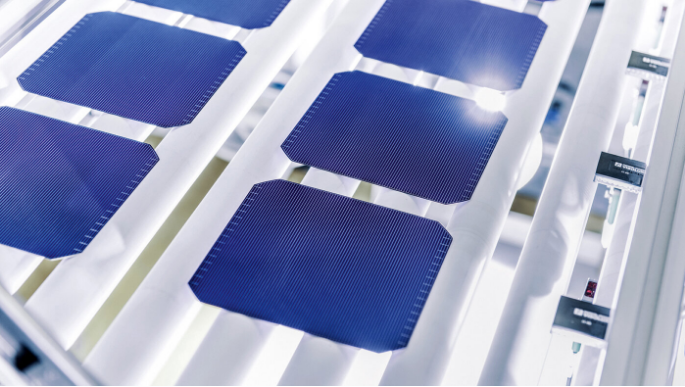as the case about five years ago for Al-BSF to PERC? PV Tech Research, as depicted in Fig. 1 [3], as almost now the whole PV community, believe so.
Fig. 1: (left) Historical data showing the switch form Al-BSF technology (blue and red bars) to PERC (brown bars) and forecast of a switch to n-type technology (grey bars) in coming years [3]. (right) Schematic cross sections for TOPCon, SHJ and poly-Si- and SHJ-IBC.
But what will be the next mainstream technology? Silicon Heterojunction (SHJ)? TOPCon? A combination of both in an Interdigitated Back Contact (IBC) structure? Tandem cells? The race is on and the muscle-showing announcements are now accelerating. PERC announcements from tier 1 manufacturers on cell and module level advancements have the aim of demonstrating that this technology is still not at its end. N-type technology announcements, however, have the function of showing which way to go in the future.
Fig. 2: (left) Efficiency (voltage) improvements and limits of c-Si technologies in the past and coming years with analogy to mobile networks 3G-6G. The graph is adapted from [4]. (right) Schematic cross sections for Al-BSF, mono and bifacial PERC, TOPCon, SHJ, IBC and 2, 3 and 4-terminal tandem configurations.
In theory this is quite simple. Fig. 2 depicts the linear yearly growth of cell efficiencies in industry of about 0.6% absolute, as presented first by Martin Hermle [4]. In 2016 the switch from Al-BSF to PERC was initiated, as Al-BSF technology reached its efficiency limit. This is mostly because of the limited passivation of the rear side by homogeneous Al-BSF, which is depicted in the cross section on the right.
With a dielectric stack (AlOx/SiNx) below the Al-Paste and Al-BSF point contacts, a better rear side passivation can be realised, leading to average voltages of 680mV and maximum of 690mV. Now, to overcome 700mV, passivating contacts with poly-Si in TOPCon or a-Si in SHJ technology have to be applied. Then, in the next step to overcome the Auger or even the Shockley-Queisser limit, tandem structures have to be used. So this linear curve is based in first order on improvements of the voltage by a better passivation with advanced cell structure.
We can compare these technologies to the mobile network and its speed. 3G (Al-BSF) is obsolete and these days the working horse is 4G (PERC), with 5G (passivating contacts) already in place. However, for most applications 4G is still sufficient and the more expensive 5G is not needed. But in a few years we will have 5G everywhere and be preparing the ground even for 6G (tandem).
High efficiency announcements show nothing else than the practical limit of each technology, which is depicted in the graph in Fig. 2. However there is a gap of about 1% absolute between what is possible (with tricks in process flow and in measurements) and what is realistic in production. We have already written in the blog “Future industrial PV technologies: Champion cell announcements versus industrial reality” in 2019, and explained in detail, with which tricks the high efficiency solar cells are fabricated and measured [5]. They very often do not have much to do with their industrial counterpart, even if the technology is named the same. In addition, even the measurements have very often some tricks included (0 Busbar measurements of even active area only, the use conductive and reflective chuck, etcetera).
Table 1 summarises this matter, depicting the record announcements versus average efficiencies in production and available module efficiencies on the market, as well as its potential.
Future industrial solar PV technologies: Champion cell announcements versus industrial reality
Heterojunction is one such technology vying for competitive edge in the solar market.
Source:PVTECH






